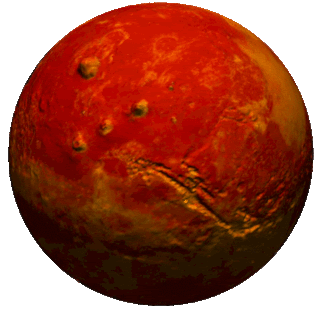Olympus Mons is a remarkable shield volcano situated on the Tharsis volcanic plateau on the planet Mars. It stands as a testament to the unique geologic and volcanic history of the Red Planet. With its colossal dimensions, it holds the distinction of being not only the tallest volcano on Mars but also the largest known volcano in the entire solar system.
Olympus Mons stands as a captivating testament to the geological wonders of the solar system, offering valuable insights into the dynamic processes that shape planets. Its monumental size and unique characteristics continue to intrigue scientists and space enthusiasts alike, serving as a symbol of the ongoing quest to unravel the mysteries of the cosmos.
Location
Tharsis volcanic plateau, Mars
Physical Characteristics
Olympus Mons boasts an impressive summit caldera that spans approximately 370 miles (600 kilometers) in diameter, large enough to accommodate the metropolitan area of a major terrestrial city. Its central peak rises to an astonishing height of approximately 72,000 feet (21.9 kilometers) above the Martian plains, making it nearly three times the height of Mount Everest, the tallest peak on Earth.
The volcano’s gentle, shield-like slopes contribute to its unique appearance. These slopes are the result of relatively fluid lava flows that have erupted from the volcano’s central vent and spread over its surface, gradually building up its immense bulk over millions of years.
Formation and Geological Significance
Olympus Mons is a product of the planet’s complex tectonic and volcanic history. It formed through a combination of hotspot volcanism and the planet’s thin crust. As the Martian lithosphere shifted over a stationary hotspot, the volcano’s multiple eruptions over time led to the accumulation of extensive lava layers, creating its iconic shield shape.
The region’s low surface pressure and gravity have allowed for the growth of enormous volcanoes like Olympus Mons, as they can accumulate lava without collapsing under their own weight, a phenomenon not commonly observed on Earth.
Surface Features
The surface of Olympus Mons is characterized by a variety of geological features resulting from its volcanic activity. Vast lava plains, lava tubes, and intricate channels carved by flowing magma are prominent on its slopes. The caldera itself is punctuated by fissures, fractures, and radial valleys, which offer insights into the volcano’s geological evolution.
Exploration and Study
Olympus Mons has been a focal point for scientific study and exploration missions to Mars. Spacecraft and rovers have provided valuable data about the volcano’s composition, geology, and history. These missions have yielded insights into the planet’s volcanic processes, climate history, and potential for past or present habitability.
